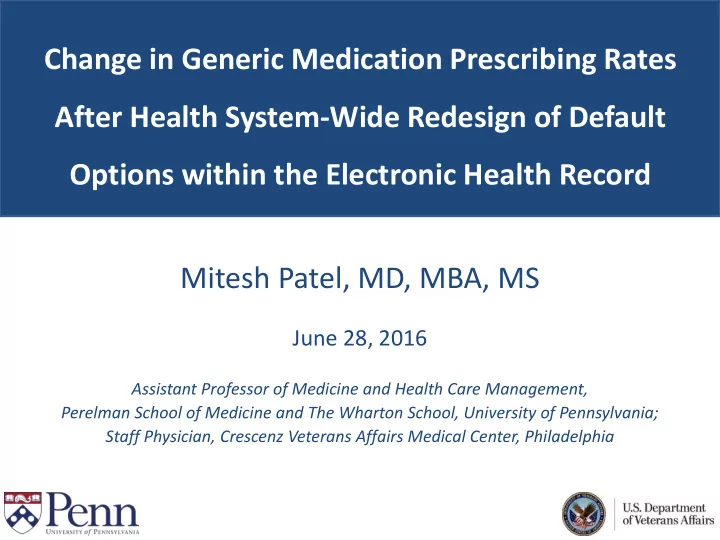

Change in Generic Medication Prescribing Rates After Health System-Wide Redesign of Default Options within the Electronic Health Record Mitesh Patel, MD, MBA, MS June 28, 2016 Assistant Professor of Medicine and Health Care Management, Perelman School of Medicine and The Wharton School, University of Pennsylvania; Staff Physician, Crescenz Veterans Affairs Medical Center, Philadelphia
Medical Decision-Making and the EHR • Manner in which choices are offered and framed significantly influences our decisions – Electronic health record (EHR) is a choice environment – Design of default options within the EHR is often overlooked and its impact on health care behaviors has not been well examined • Default options are the path of least resistance – Influence decisions without restricting choice • Optimal setting when dominant option is clear – Brand name medications with available generic equivalents Halpern et al. NEJM. 2007. Patel et al. JGIM . 2012
Generics Utilization Improves Adherence and Outcomes • 40% of Medicare beneficiaries with cardiovascular disease were prescribed brand names that had available generic equivalents • Medicare spent $1.4 billion more on brand name medications for diabetics when compared to similar patients at the VA • Estimated that at least $6 billion in drug spending could be saved by simply using generics when they are available Choudhry et al. Ann Intern Med. 2016.
Generic Utilization at Penn Medicine • Ranked in the bottom quartile among peers in generic prescribing rates • Education and feedback to clinicians had little impact • Intervention in the electronic health record – Default was changed from opt-in to opt-out generic substitution – Implemented across all ambulatory clinics among all specialities within the entire health system in November 2014
Objectives • To evaluate the effect of this health system-wide change in default options on physician prescribing behaviors • To test whether physicians maintained the ability to opt-out in cases where the brand name medication was preferred – Syndroid and levothyroxine often have different levels of thyroid hormone and switching can require dosage re-titration
Pre-Intervention: Opt-In Process Brand Generic
Post-Intervention: Opt-Out Process
Study Design • Data – Monthly prescription rates from Clarity, an EPIC reporting database – Pre (Jan to Oct 2014) and post (Nov 2014 to June 2015) intervention • Medications – New prescriptions associated with 10 common outpatient conditions • Acid reflux, anxiety/insomnia, bacterial infection, depression, diabetes, hyperlipidemia, hypertension/CHF, hypothyroid, pain, seizure – Excluded medications without generic equivalents and combination pills • Analysis – Chi-square tests for differences in generic prescribing rates – Difference-in-difference approach using a linear probability model to compare changes over time for synthroid/levothyroxine to other medications with similar baseline generic prescribing rates
Results 100% Percent of Prescriptions Ordered as Generic 90% 80% 70% 60% 50% 40% 75.3% 98.4% 30% P < 0.001 20% 10% 0% Acid Reflux Pain Hypertension/CHF Bacterial Infection Seizure Depression Anxiety/Insomnia Diabetes Hyperlipidemia Hypothyroid
Results - Opt-Out Differences
Limitations • Observational data from one health system • Data on prescribed, not dispensed medications – However, Penn Medicine immediately moved from bottom to top quartile based on insurer claims data on medication dispensing rates
Summary • Changing the default to an opt-out process for generic substitution led to a significant and immediate increase in generic prescribing • Low-cost intervention that did not disrupt clinician workflow and preserved their ability to easily opt-out when necessary • Further opportunities should be considered to systematically design and test interventions that change EHR choice architecture to nudge clinician behavior
Acknowledgements • Collaborators – Susan Day, MD, MPH – Scott Halpern, MD, PhD – Bill Hanson, MD – Steve Honeywell Jr, BS – Joseph Martinez, BS – Kevin Volpp, MD, PhD • Funding – University of Pennsylvania Health System – National Institute on Aging (P30AGO34546)
Change in Generic Medication Prescribing Rates After Health System-Wide Redesign of Default Options within the Electronic Health Record Mitesh Patel, MD, MBA, MS June 28, 2016 Assistant Professor of Medicine and Health Care Management, Perelman School of Medicine and The Wharton School, University of Pennsylvania; Staff Physician, Crescenz Veterans Affairs Medical Center, Philadelphia
Appendix
State Laws for Generic Substitution • State laws for generic substitution – All 50 states have generic substitution laws • Only 15 states have mandatory laws – 35 states have permissive laws • Nearly 80% require patient consent at the pharmacy, which reduces conversion to generic by 25% • Overspending on brand name medications – Medicaid wasted $329 million annually on brand names with existing generic equivalents – Medicare spent $1.4 billion more on brand name medications than the VA for diabetic patients www.ncsl.org www.pcmanet.org Shrank et al. Health Affairs. 2010;29:1383-90 AEI 2011. http://www.aei.org/paper/10020 Gellad et al. Ann Intern Med. 2013;159:105-14.
Excess Spending from Brand Name Medications Johansen et al. JAMA Internal Medicine. 2016.
Pilot Study Among General Internists IM Providers Medications x P-value Post-Intervention 5.4 <0.001 All 10.5 <0.001 Beta-Blockers 4.0 <0.01 Statins 2.1 0.47 PPIs
Recommend
More recommend